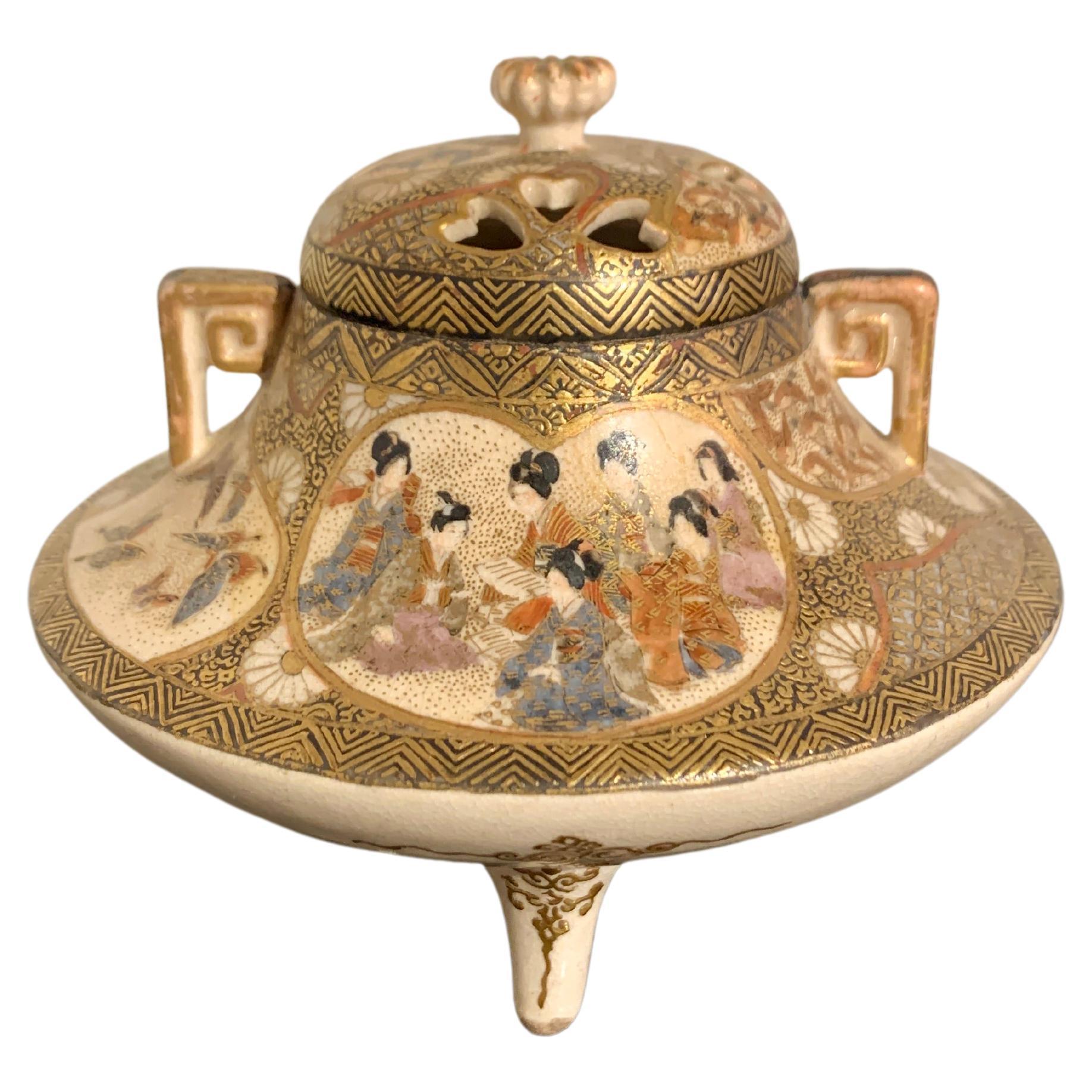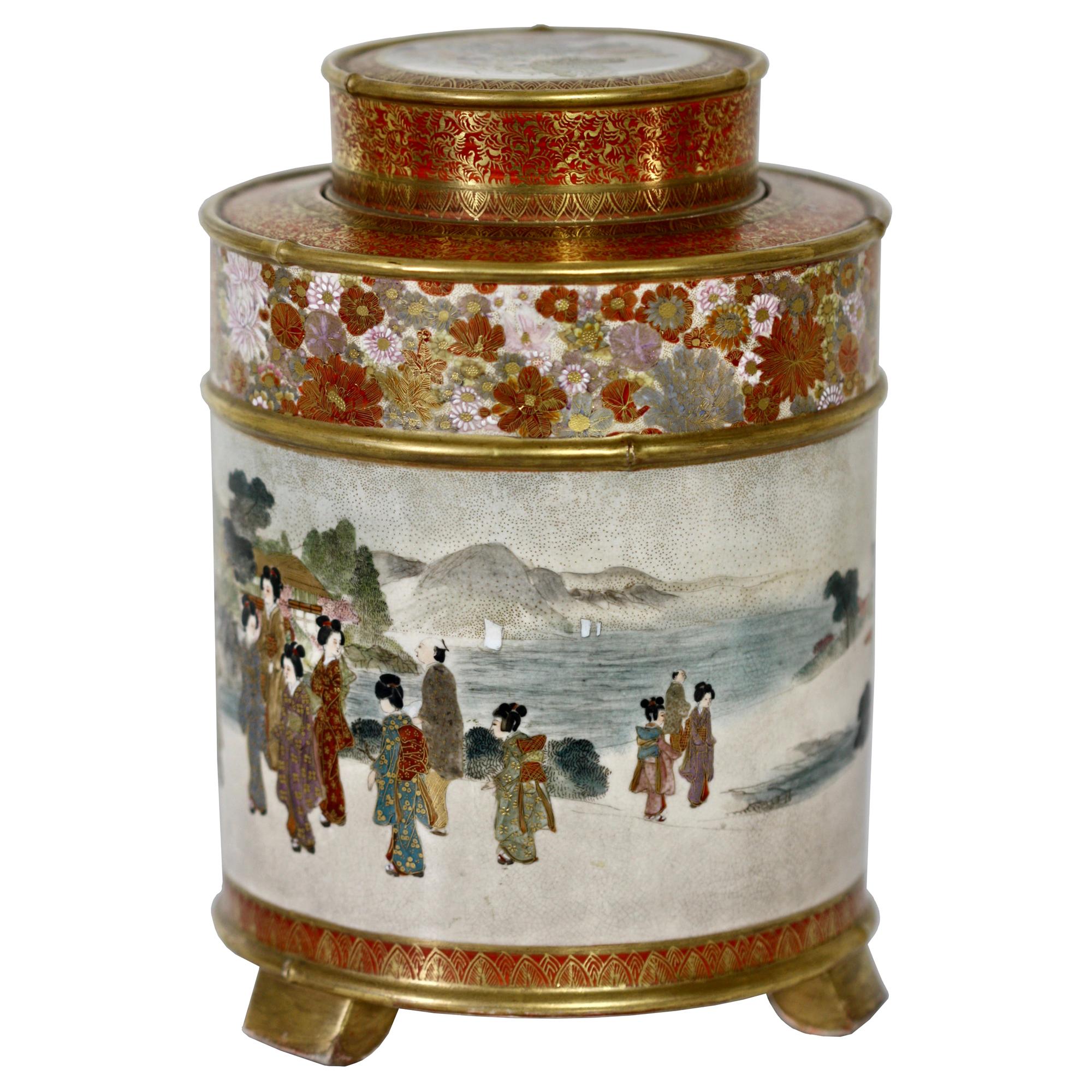Items Similar to Antique Japanese Meiji Period Satsuma Koro Kizan
Want more images or videos?
Request additional images or videos from the seller
1 of 21
Antique Japanese Meiji Period Satsuma Koro Kizan
About the Item
Meiji Period (1868-1912)
From our Japanese collection, we are pleased to offer this Antique Japanese Meiji Period Satsuma Koro by Kizan. The Koro of squat bombe form raised upon angled feet with a central raised neck surmounted by a chrysanthemum flower handle. The exterior of the Koro is painted with four large scenes framed by a black pinstripe. Each scene features a vase landscape with figures or birds to the foreground with flowers and foliage including cherry blossom and bamboo. The neck of the vase is decorated with various geometric patterns, flowers and shapes matching the lid with greek key borders. The underside of the Koro is signed with a two character mark 貴山 for Kizan and dates to the late 19th century during the Meiji Period (1868-1912) circa 1895.
Kizan was a Meiji Period (1868-1912) artist who signed his works in various forms including 輝山, 琪山, 竒山, 喜山, 貴山 and 暉山. Kizan was a good level Satsuma artist and worked for the Yasuda company under Ryozan.
Koro, a squat broad-mouthed covered jar usually made from bronze, pottery or jade which is used as an incense burner. The lids of the Koro often contain pierced sections which release the incense from the body of the Koro.
Meiji Period was an era of Japanese history that spanned from 1868 to 1912. It was the first half of the Empire of Japan, when the Japanese people began to build a paradigm of a modern, industrialised nation state and emergent great power, influenced by Western countries and aesthetics. As a result of radically different ideas, the changes to Japan were profound and it affected the social structure, politics, economy, military, and foreign relations across the board. The period corresponded to the reign of Emperor Meiji and was preceded by the Keio era and was succeeded by the Taisho era.
Cultural Art during the Meiji Period was of particular interest to the government and they overhauled the art export market which in turn promoted Japanese arts via various world’s fairs, beginning in Vienna at the world fair in 1873. The government heavily funded the fairs and took an active role organising how Japan’s culture was presented to the world including creating a semi-public company named Kiritsu Kosho Kaisha (First Industrial Manufacturing Company). The Kiritsu Kosho Kaisha was used to promote and commercialise exports of Japanese art and established the Hakurankai Jimukyoku (Exhibition Bureau) to maintain quality standards. For the 1876 Centennial International Exhibition in Philadelphia, the Japanese government created a Centennial Office and sent a special envoy to secure space for the 30,000 items that would be displayed. The Imperial Household also took an active interest in arts and crafts, commissioning works by select artists to be given as gifts for foreign dignitaries further emphasising the high quality and importance of Japanese art. Just before the end of the 19th century in 1890, the Teishitsu Gigeiin (Artist to the Imperial Household) system was created to recognise distinguished artists. These artists were selected for their exceptionally high quality wares and talent in their own industry. Over a period of 54 years Seventy artists were appointed, amongst these were ceramicist Makuzu Kozan and cloisonné enamel artist Namikawa Yasuyuki.
Satsuma ware is a type of earthenware pottery originating from the Satsuma province in Southern Kyushu, Japan’s third largest island.
Antique, a collectable object such as a piece of furniture or work of art that has a high value because of its age and quality. Objects of this nature are generally considered antique at 100 plus years of age.
Measurements (centimetres) 14.5cm High x 10cm Wide x 8.5cm Deep
- Dimensions:Height: 5.7 in (14.48 cm)Width: 3.9 in (9.91 cm)Depth: 3.35 in (8.51 cm)
- Style:Meiji (Of the Period)
- Materials and Techniques:
- Place of Origin:
- Period:
- Date of Manufacture:Circa 1895
- Condition:
- Seller Location:Newark, GB
- Reference Number:
About the Seller
5.0
Vetted Seller
These experienced sellers undergo a comprehensive evaluation by our team of in-house experts.
Established in 2019
1stDibs seller since 2022
18 sales on 1stDibs
Typical response time: 3 hours
- ShippingRetrieving quote...Ships From: Newark, United Kingdom
- Return PolicyA return for this item may be initiated within 14 days of delivery.
More From This SellerView All
- Japanese Meiji Period Satsuma Bowl KinkozanBy KinkozanLocated in Newark, EnglandFrom our Japanese collection, we are delighted to offer this Japanese Meiji period Satsuma Bowl by Kinkozan. The earthenware bowl with pinched rim extensively decorated on both the exterior and interior. The bowl with a cobalt blue base glaze decorated to the borders with gilt shippo-tsunagi (linked-cash) with scattered medallion roundells. Around the exterior two elongated scenes are featured, one with boys playing games in a courtyard with the other featuring seated scholars in full dress both with raised enamel decoration. The interior features a central scene with Samurai warriors in training fully armoured with swords in a courtyard with landscapes scenes to the background. The central scene bordered by further stylised shippo-tsunagi type decoration with a greek key rim border. The bowl signed to the base Kinkozan dating to the Meiji Period (1868-1912) circa 1900. Shippo-Tsunagi (linked-cash) or seven treasures, is a traditional Japanese geometric pattern that combines four ellipses in a circle. These ellipses repeat outward to then create more circles, symbolising eternal peace and happiness. Kinkozan the Kinkozan family have been associated with pottery dating back to 1645. They went on to become the largest producer of Satsuma ware by one individual company, from the end of the 19th century until 1927 after which the factory closed. By the 1850s Kobayashi Sobei (1824-84), Kinkozan Sobei...Category
Antique Early 1900s Japanese Meiji Ceramics
MaterialsCeramic, Earthenware, Pottery, Faux Leather
- Japanese Hand Painted Meiji Period Satsuma VaseBy KinkozanLocated in Newark, EnglandSquat Bulbous Form From our Japanese collection, we are delighted to offer this Japanese Meiji Period Satsuma Vase. The Satsuma vase of squat bulbous form with a tightly pinched nec...Category
Antique Late 19th Century Japanese Meiji Ceramics
MaterialsCeramic, Earthenware, Pottery
- Japanese Meiji Period Satsuma Vase by KinkozanBy KinkozanLocated in Newark, EnglandThe vase is potted in globular form with a tightly pinched neck and rolled top rim beautifully decorated with four highly detailed individual panelled scenes. The first a Geisha bari...Category
Antique Late 19th Century Japanese Meiji Ceramics
MaterialsCeramic, Earthenware, Pottery
- Japanese Meiji Period Satsuma Bowl Signed SuizanLocated in Newark, EnglandJapanese Meiji period satsuma scalloped shaped bowl. The bowl of beautiful form with gilt pin-striping and dotting to the accented areas. The exterior decorated with multiple fish swimming around the outside with small flower sprays between. To the inside a painted netting covers the bowl with butterflies and further floral sprays. The centre decorated with representations of each of the woodcut prints from Hiroshige's Tokaido gojusan tsugi (53 Stations of the Tokaido Road). To the base a stylised cartouche signature within an oval for Suizan. This Japanese satsuma bowl...Category
Antique Late 19th Century Japanese Meiji Ceramics
MaterialsCeramic, Earthenware, Pottery
- Japanese Meiji Period Satsuma Vase Painted by Ryozan for the Yasuda CompanyLocated in Newark, EnglandThe vase of slightly bulbous form potted with a tapered body reaching a slightly pinched neck and rolled top rim is beautifully decorated with two large scenes. The first scene featu...Category
Antique Early 1900s Japanese Meiji Ceramics
MaterialsCeramic, Earthenware, Pottery
- Japanese Satsuma Natsume KinkozanBy KinkozanLocated in Newark, EnglandCobalt Blue Natsume From our Japanese collection, we are delighted to offer this Japanese Satsuma Natsume by Kinkozan. The Natsume of elongated rectangular form with four recessed panels each bordered by a gilt foliage decoration. The Natsume raised upon a square base with a scalloped centre. The top of the Satsuma finished with the original lid with matching gilt foliage decoration. The panels of the Satsuma decorated with multiple figures in various pursuits framed within a shaped recesses. The base of the Satsuma is signed with the Kinkozan mark. The Natsume dates to the Meiji Period (1868-1912) circa 1890. Natsume is a Chaki 茶器 (tea implement) used in a Japanese Tea Ceremony and is a term for a Japanese Tea Caddy...Category
Antique Late 19th Century Japanese Meiji Ceramics
MaterialsEnamel
You May Also Like
- Antique Japanese Meiji Period Satsuma Pottery Bowl Imperial Figures Kizan 1890Located in Portland, ORA very fine antique Japanese Meiji period Satsuma pottery bowl, circa 1890. The bowl having a lobed rim and finely decorated & gilt to the outside with a 'thousand flowers' decoratio...Category
Antique 1890s Japanese Meiji Ceramics
MaterialsPottery
- Antique Japanese Satsuma Mini Koro Incense Burner Japan Meiji PeriodLocated in Amsterdam, Noord HollandDescription: Fabulous Japanese Satsuma koros. Small red marks on both lid and koro, 19th century. Condition: Overall condition perfect. Size: 85 x 80mm H x D Period: Meiji P...Category
Antique 19th Century Japanese Meiji Ceramics
MaterialsEarthenware
- Japanese Satsuma Incense Burner, Koro, Meiji Period, Late 19th Century, JapanLocated in Austin, TXA fine and elegant Japanese Satsuma tripod incense burner, koro, with pierced metal lid, signed Eizan (?) Meiji Period, late 19th century, Japan. The koro, or censer, features a stoneware body of slightly compressed globular form, supported on three short and squat legs. The wide mouth with a recessed metal rim, and topped by an openwork metal lid topped with overlapping chrysanthemum blossoms of silver repousse. The body of the koro finely painted with fan shaped cartouches. The fans in the foreground with sprays of blossoming chrysanthemum. The fans in the background with intricate geometric brocade designs. The shoulder of the incense burner decorated with cartouches formed as stylized chrysanthemum petals, and intricately decorated with geometric and floral brocade designs. The painting finely done in raised gilt and polychrome enamels, including the highly desirable gosu blue...Category
Antique Late 19th Century Japanese Meiji Ceramics
MaterialsMetal, Silver
- Japanese Satsuma Tripod Censer, Koro, Meiji period, Early 20th Century, JapanLocated in Austin, TXA small and finely decorated Japanese Satsuma tripod incense burner (koro), signed Kyozan, Meiji period, circa 1900, Japan. The censer, koro, with a compressed body supported by t...Category
Antique Early 1900s Japanese Meiji Ceramics
MaterialsStoneware
- Japanese Satsuma Cylindrical Koro and Cover, Signed Gyokuzan, Meiji PeriodLocated in West Palm Beach, FLA Japanese Satsuma cylindrical koro and cover, signed Gyokuzan, Meiji period (1868-1912) Raised on three supports, painted and gilt with a continuous scene of ladies and children p...Category
Antique 19th Century Ceramics
MaterialsCeramic
- Lovely 19c Antique Meiji Period Japanese Koro Bronze CloisonneLocated in Amsterdam, Noord HollandDescription Lovely and beautifully made piece. Provenance: Originally part of the Catherina collection of Japanese bronzes and cloisonne that was partly auctioned in Amsterd...Category
Antique 19th Century Japanese Meiji Ceramics
MaterialsBronze
Recently Viewed
View AllMore Ways To Browse
15th Century Celadon
Asian Scenes
Jarrones Chinos
Contemporary Stone Object Table
Brass Limburg
Sevres Porcelain Pair
Dress Lamp
Pair Of Chests Of Drawers Mid Century
Antique Storage Side Table
Italian Modern Leather Sofa Black
Antique Heriz Serapi Rug Geometric
Handmade Coffee Table Marble
Kimono From Japan
Rectangular Armchair
Nineteenth Century Glass
Small Powder Room Rug
Art Deco Bar Objects
Vintage Herman Miller Office Chair Set




